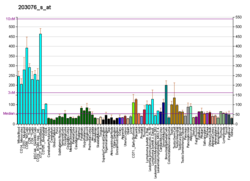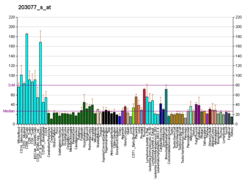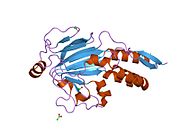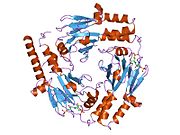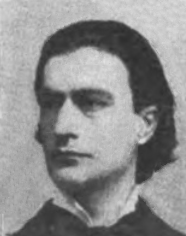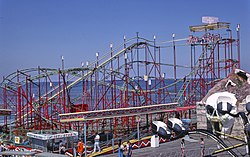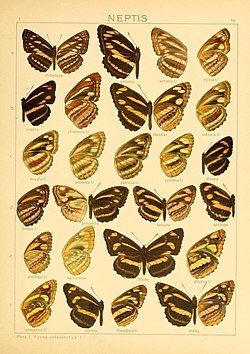반신불수 호몰로그 2에 반대하는 엄마들
Mothers against decapentaplegic homolog 2SMAD 패밀리 2 또는 SMAD2로도 알려진 탈피성 호몰로그 2에 대한 산모는 SMAD2 [5][6]유전자에 의해 인간에게 암호화되는 단백질이다.MAD 호몰로그 2는 '탈수성 마비증에 반대하는 엄마들'과 C. elegans 유전자 Sma의 유전자 산물과 유사한 단백질 패밀리인 SMAD에 속합니다.SMAD 단백질은 여러 신호 경로를 매개하는 신호 변환기 및 전사 조절기입니다.
기능.
SMAD2는 변환성장인자(TGF)-베타의 신호를 매개하여 세포의 증식, 아포토시스, 분화 등의 여러 세포 프로세스를 조절합니다.이 단백질은 수용체 활성화(SARA) 단백질에 대한 SMAD 앵커와의 상호작용을 통해 TGF-베타 수용체에 공급된다.TGF-베타 신호에 반응하여 이 단백질은 TGF-베타 수용체에 의해 인산화된다.인산화 작용은 SARA와 이 단백질의 해리를 유도하고 SMAD4 가족과의 연관성을 유도한다.SMAD4와의 연관성은 표적 촉진제에 결합하고 다른 보조 인자와 전사 억제 복합체를 형성하는 세포핵으로의 이 단백질의 전위치에 중요하다.이 단백질은 또한 액티빈 타입 1 수용체 키나제에 의해 인산화 될 수 있으며, 액티빈으로부터의 신호를 매개한다.동일한 단백질을 코드하는 대체적으로 스플라이스된 전사 변이가 [7]관찰되었다.
다른 Smads와 마찬가지로 Smad2는 성장 인자의 TGFβ 슈퍼패밀리의 리간드에서 세포핵으로 세포외 신호를 전달하는 역할을 한다.TGFβ 슈퍼패밀리 리간드의 서브그룹이 세포외 수용체에 결합함으로써 C 말단에서 세린-세린-메티오닌-세린(SSMS) 모티브에서 Smad2의 인산화 유발.인산화된 Smad2는 Smad4와 복합체를 형성할 수 있다.이러한 복합체는 세포핵에 축적되어 유전자 발현 조절에 직접 관여한다.
명명법
SMAD 단백질은 드로소필라 단백질, 디카펜타플라이그(MAD) 및 C. 엘레건스 단백질 SMA의 상동체입니다.이름은 이 둘을 조합한 것입니다.Drosophila 연구 중에, 모체의 유전자 MAD의 돌연변이가 배아의 유전자 탈수증을 억제한다는 것이 발견되었다.엄마들이 음주운전에 반대하는 엄마들(MADD)과 같은 다양한 이슈에 반대하는 단체를 결성하는 경우가 많기 때문에 "엄마들이 반대한다"는 문구가 추가되었다.이 단백질의 명명법은 유전자 연구 공동체 [8]내에서 그러한 특이한 이름의 전통에 기초하고 있습니다.
상호 작용
탈수성 호몰로그 2에 반대하는 산모들은 다음과 같은 반응을 보이는 것으로 나타났다.
레퍼런스
- ^ a b c GRCh38: 앙상블 릴리즈 89: ENSG00000175387 - 앙상블, 2017년 5월
- ^ a b c GRCm38: 앙상블 릴리즈 89: ENSMUSG000024563 - 앙상블, 2017년 5월
- ^ "Human PubMed Reference:". National Center for Biotechnology Information, U.S. National Library of Medicine.
- ^ "Mouse PubMed Reference:". National Center for Biotechnology Information, U.S. National Library of Medicine.
- ^ Eppert K, Scherer SW, Ozcelik H, Pirone R, Hoodless P, Kim H, Tsui LC, Bapat B, Gallinger S, Andrulis IL, Thomsen GH, Wrana JL, Attisano L (August 1996). "MADR2 maps to 18q21 and encodes a TGFbeta-regulated MAD-related protein that is functionally mutated in colorectal carcinoma". Cell. 86 (4): 543–52. doi:10.1016/S0092-8674(00)80128-2. PMID 8752209. S2CID 531842.
- ^ Riggins GJ, Thiagalingam S, Rozenblum E, Weinstein CL, Kern SE, Hamilton SR, Willson JK, Markowitz SD, Kinzler KW, Vogelstein B (July 1996). "Mad-related genes in the human". Nat. Genet. 13 (3): 347–9. doi:10.1038/ng0796-347. PMID 8673135. S2CID 10124489.
- ^ "Entrez Gene: SMAD2 SMAD family member 2".
- ^ "Sonic Hogso, DICER, and the Problem With Naming Genes", 2014년 9월 26일, Michael White. psmag.com
- ^ Nourry C, Maksumova L, Pang M, Liu X, Wang T (May 2004). "Direct interaction between Smad3, APC10, CDH1 and HEF1 in proteasomal degradation of HEF1". BMC Cell Biol. 5: 20. doi:10.1186/1471-2121-5-20. PMC 420458. PMID 15144564.
- ^ Hocevar BA, Smine A, Xu XX, Howe PH (June 2001). "The adaptor molecule Disabled-2 links the transforming growth factor β receptors to the Smad pathway". EMBO J. 20 (11): 2789–801. doi:10.1093/emboj/20.11.2789. ISSN 0261-4189. PMC 125498. PMID 11387212.
- ^ a b c d Wotton D, Lo RS, Lee S, Massagué J (April 1999). "A Smad transcriptional corepressor". Cell. 97 (1): 29–39. doi:10.1016/S0092-8674(00)80712-6. ISSN 0092-8674. PMID 10199400. S2CID 6907878.
- ^ a b Pessah M, Prunier C, Marais J, Ferrand N, Mazars A, Lallemand F, Gauthier JM, Atfi A (May 2001). "c-Jun interacts with the corepressor TG-interacting factor (TGIF) to suppress Smad2 transcriptional activity". Proc. Natl. Acad. Sci. U.S.A. 98 (11): 6198–203. Bibcode:2001PNAS...98.6198P. doi:10.1073/pnas.101579798. ISSN 0027-8424. PMC 33445. PMID 11371641.
- ^ Liu B, Dou CL, Prabhu L, Lai E (January 1999). "FAST-2 Is a Mammalian Winged-Helix Protein Which Mediates Transforming Growth Factor β Signals". Mol. Cell. Biol. 19 (1): 424–30. doi:10.1128/MCB.19.1.424. ISSN 0270-7306. PMC 83900. PMID 9858566.
- ^ Liu F, Pouponnot C, Massagué J (December 1997). "Dual role of the Smad4/DPC4 tumor suppressor in TGFβ-inducible transcriptional complexes". Genes Dev. 11 (23): 3157–67. doi:10.1101/gad.11.23.3157. ISSN 0890-9369. PMC 316747. PMID 9389648.
- ^ Dou C, Lee J, Liu B, Liu F, Massague J, Xuan S, Lai E (September 2000). "BF-1 Interferes with Transforming Growth Factor β Signaling by Associating with Smad Partners". Mol. Cell. Biol. 20 (17): 6201–11. doi:10.1128/MCB.20.17.6201-6211.2000. ISSN 0270-7306. PMC 86095. PMID 10938097.
- ^ Chen X, Weisberg E, Fridmacher V, Watanabe M, Naco G, Whitman M (September 1997). "Smad4 and FAST-1 in the assembly of activin-responsive factor". Nature. 389 (6646): 85–9. Bibcode:1997Natur.389...85C. doi:10.1038/38008. ISSN 0028-0836. PMID 9288972. S2CID 11927346.
- ^ O'Neill TJ, Zhu Y, Gustafson TA (April 1997). "Interaction of MAD2 with the carboxyl terminus of the insulin receptor but not with the IGFIR. Evidence for release from the insulin receptor after activation". J. Biol. Chem. 272 (15): 10035–40. doi:10.1074/jbc.272.15.10035. ISSN 0021-9258. PMID 9092546.
- ^ Labbé E, Letamendia A, Attisano L (July 2000). "Association of Smads with lymphoid enhancer binding factor 1/T cell-specific factor mediates cooperative signaling by the transforming growth factor-β and Wnt pathways". Proc. Natl. Acad. Sci. U.S.A. 97 (15): 8358–63. Bibcode:2000PNAS...97.8358L. doi:10.1073/pnas.150152697. ISSN 0027-8424. PMC 26952. PMID 10890911.
- ^ Feng XH, Liang YY, Liang M, Zhai W, Lin X (January 2002). "Direct interaction of c-Myc with Smad2 and Smad3 to inhibit TGF-beta-mediated induction of the CDK inhibitor p15(Ink4B)". Mol. Cell. 9 (1): 133–43. doi:10.1016/S1097-2765(01)00430-0. ISSN 1097-2765. PMID 11804592.
- ^ Quinn ZA, Yang CC, Wrana JL, McDermott JC (February 2001). "Smad proteins function as co-modulators for MEF2 transcriptional regulatory proteins". Nucleic Acids Res. 29 (3): 732–42. doi:10.1093/nar/29.3.732. PMC 30396. PMID 11160896.
- ^ Long J, Wang G, Matsuura I, He D, Liu F (January 2004). "Activation of Smad transcriptional activity by protein inhibitor of activated STAT3 (PIAS3)". Proc. Natl. Acad. Sci. U.S.A. 101 (1): 99–104. Bibcode:2004PNAS..101...99L. doi:10.1073/pnas.0307598100. ISSN 0027-8424. PMC 314145. PMID 14691252.
- ^ a b Nakano A, Koinuma D, Miyazawa K, Uchida T, Saitoh M, Kawabata M, Hanai J, Akiyama H, Abe M, Miyazono K, Matsumoto T, Imamura T (March 2009). "Pin1 down-regulates transforming growth factor-beta (TGF-beta) signaling by inducing degradation of Smad proteins". J. Biol. Chem. 284 (10): 6109–15. doi:10.1074/jbc.M804659200. ISSN 0021-9258. PMID 19122240.
- ^ Harada J, Kokura K, Kanei-Ishii C, Nomura T, Khan MM, Kim Y, Ishii S (October 2003). "Requirement of the co-repressor homeodomain-interacting protein kinase 2 for ski-mediated inhibition of bone morphogenetic protein-induced transcriptional activation". J. Biol. Chem. 278 (40): 38998–9005. doi:10.1074/jbc.M307112200. ISSN 0021-9258. PMID 12874272.
- ^ Luo K, Stroschein SL, Wang W, Chen D, Martens E, Zhou S, Zhou Q (September 1999). "The Ski oncoprotein interacts with the Smad proteins to repress TGFβ signaling". Genes Dev. 13 (17): 2196–206. doi:10.1101/gad.13.17.2196. ISSN 0890-9369. PMC 316985. PMID 10485843.
- ^ Stroschein SL, Bonni S, Wrana JL, Luo K (November 2001). "Smad3 recruits the anaphase-promoting complex for ubiquitination and degradation of SnoN". Genes Dev. 15 (21): 2822–36. doi:10.1101/gad.912901. ISSN 0890-9369. PMC 312804. PMID 11691834.
- ^ Stroschein SL, Wang W, Zhou S, Zhou Q, Luo K (October 1999). "Negative feedback regulation of TGF-beta signaling by the SnoN oncoprotein". Science. 286 (5440): 771–4. doi:10.1126/science.286.5440.771. ISSN 0036-8075. PMID 10531062.
- ^ Nakao A, Imamura T, Souchelnytskyi S, Kawabata M, Ishisaki A, Oeda E, Tamaki K, Hanai J, Heldin CH, Miyazono K, ten Dijke P (September 1997). "TGF-beta receptor-mediated signalling through Smad2, Smad3 and Smad4". EMBO J. 16 (17): 5353–62. doi:10.1093/emboj/16.17.5353. ISSN 0261-4189. PMC 1170167. PMID 9311995.
- ^ Lebrun JJ, Takabe K, Chen Y, Vale W (January 1999). "Roles of pathway-specific and inhibitory Smads in activin receptor signaling". Mol. Endocrinol. 13 (1): 15–23. doi:10.1210/mend.13.1.0218. ISSN 0888-8809. PMID 9892009.
- ^ Lin X, Liang M, Feng XH (November 2000). "Smurf2 is a ubiquitin E3 ligase mediating proteasome-dependent degradation of Smad2 in transforming growth factor-beta signaling". J. Biol. Chem. 275 (47): 36818–22. doi:10.1074/jbc.C000580200. ISSN 0021-9258. PMID 11016919.
- ^ Bonni S, Wang HR, Causing CG, Kavsak P, Stroschein SL, Luo K, Wrana JL (June 2001). "TGF-beta induces assembly of a Smad2-Smurf2 ubiquitin ligase complex that targets SnoN for degradation". Nat. Cell Biol. 3 (6): 587–95. doi:10.1038/35078562. ISSN 1465-7392. PMID 11389444. S2CID 23270947.
- ^ Leong GM, Subramaniam N, Figueroa J, Flanagan JL, Hayman MJ, Eisman JA, Kouzmenko AP (May 2001). "Ski-interacting protein interacts with Smad proteins to augment transforming growth factor-beta-dependent transcription". J. Biol. Chem. 276 (21): 18243–8. doi:10.1074/jbc.M010815200. ISSN 0021-9258. PMID 11278756.
- ^ Datta PK, Moses HL (May 2000). "STRAP and Smad7 Synergize in the Inhibition of Transforming Growth Factor β Signaling". Mol. Cell. Biol. 20 (9): 3157–67. doi:10.1128/MCB.20.9.3157-3167.2000. ISSN 0270-7306. PMC 85610. PMID 10757800.
추가 정보
- Wrana JL (1998). "TGF-beta receptors and signalling mechanisms". Mineral and Electrolyte Metabolism. 24 (2–3): 120–30. doi:10.1159/000057359. PMID 9525694. S2CID 84458561.
- Massagué J (1998). "TGF-beta signal transduction". Annu. Rev. Biochem. 67: 753–91. doi:10.1146/annurev.biochem.67.1.753. PMID 9759503.
- Verschueren K, Huylebroeck D (2000). "Remarkable versatility of Smad proteins in the nucleus of transforming growth factor-beta activated cells". Cytokine Growth Factor Rev. 10 (3–4): 187–99. doi:10.1016/S1359-6101(99)00012-X. PMID 10647776.
- Wrana JL, Attisano L (2000). "The Smad pathway". Cytokine Growth Factor Rev. 11 (1–2): 5–13. doi:10.1016/S1359-6101(99)00024-6. PMID 10708948.
- Miyazono K (2000). "TGF-beta signaling by Smad proteins". Cytokine Growth Factor Rev. 11 (1–2): 15–22. doi:10.1016/S1359-6101(99)00025-8. PMID 10708949.
- Zannis VI, Kan HY, Kritis A, Zanni E, Kardassis D (March 2001). "Transcriptional regulation of the human apolipoprotein genes". Front. Biosci. 6: D456–504. doi:10.2741/Zannis. PMID 11229886.






